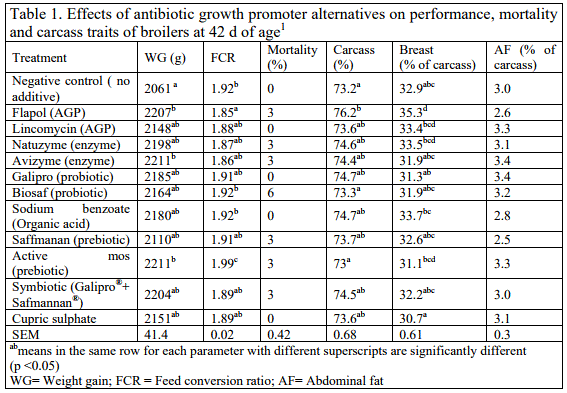Introduction
Antibiotic growth promoters (AGP) are used worldwide to prevent poultry pathogens and disease so as to improve meat and egg production. However, the use of AGP resulted in common problems such as development of drug-resistant bacteria, drug residues in the body of birds, and imbalance of normal microflora. As a consequence, it has become necessary to develop alternatives using either beneficial microorganisms or nondigestible ingredients that enhance growth (Awad et al 2009). Recently a variety of products has been developed as an alternative to AGPs that could be added to the feed of a poultry flock to improve production or to reduce the spread of diseases (Griggs and Jacob 2005). Some of these potential additives are enzymes, probiotics, prebiotics, synbiotics, organic acids, cupric sulfate, essential oils and other plant-derived products. Little researches have been conducted in order to compare different industrial additives. This study was conducted to compare the efficacy of these products as an alternative to AGPs.
Material and Methods
Three hundred ninety-six male broiler chicks were randomly assigned in a completely randomized design with 3 replicates to 12 treatment groups: A negative control diet without any additive, 2 AGPs as positive controls (Lincomycin® and Flapol® ) , 2 probiotics (Galipro® and Biosaf® ); 2 prebiotics (Safmannan® and Active mos® ); 2 enzymes (Avizyme® and Natuzyme® ); a symbiotic (Galipro® + Safmannan® ), cupric sulphate (Cu) and an organic acid (sodium benzoate). Experimental period was between 14 to 42 days of age. Feed intake and weight gain measured weekly and mortality recorded daily. At the end of the experiment, samples of birds were slaughtered and carcass traits were measured. Data were analyzed by GLM procedure of SPSS (16). Duncan multiple range test was used for mean comparison.
Result and Discussion
All additives improved (p<0.05) weight gain (up to 7%), feed intake and feed conversion ratio (up to 4%) relative to negative control (table 1). The best performance obtained by AGPs. Treatments had not significant effects on mortality rate. Carcass traits (including carcass, breast, thigh and abdominal fat percentage) were not significantly different between AGP and its alternatives but carcass and breast percentage were different from negative control (Table 1; p<0.05). Overall, the results suggested that AGPs can be effectively substituted by different alternatives (enzymes, symbiotic and Cu in this experiment). These findings were consistent with Awad et al (2009), Griggs and Jacob (2005) and Owens et al (2008).
Presented at the 18th European Symposium on Poultry Nutrition.
References
Awad, WA, Ghareeb K, Abdel-Raheem S, Böhm J. 2009. Effects of dietary inclusion of probiotic and synbiotic on growth performance, organ weights, and intestinal histomorphology of broiler chickens. Poult Sci.88: 49-56
Griggs JP, Jacob JP, 2005. Alternatives to Antibiotics for Organic Poultry Production. J Appl Poult Res. 14:750 756
Owens B, Tucker L, Collins MA, McCracken KJ. 2008. Effects of different feed additives alone or in combination on broiler performance, gut microflora and ileal histology. Br Poult Sci. 49: 202-212.















